Scotland's Devolved Employment Services: statistical summary August 2021
This publication presents statistics for Fair Start Scotland (FSS) from April 2018 to June 2021 and experimental statistics on the No One Left Behind strategic approach to employability delivery, reporting on those receiving support from April 2019 to March 2021.
No One Left Behind (Experimental Statistics)
Introduction
No One Left Behind is a strategy for placing people at the centre of the design and delivery of employability services. The transition to this new approach, delivered through a partnership agreement between Scottish and Local Government, commenced on 1 April 2019.
The No One Left Behind approach moves away from funding and delivering a number of separate and distinct employability programmes, to a more flexible approach. Scottish and Local Government are working with third and private sector to deliver support which aims to be more joined-up and responsive to the needs of individuals of all ages and to local labour market conditions.
The support provided may vary from short, focused interventions or longer term support, dependent on individual circumstances. Participants can access the support they require on an ongoing basis and can engage and disengage at times that best suit their needs.
Individuals can self-refer to No One Left Behind support, or be referred through a variety of channels, including educational providers, local authorities, third sector organisations, Jobcentre Plus, and other local services.
How many people received support?
A total of 7,390 people were supported over the period April 2019 to March 2021, with 3,824[18] people starting in year 1 (April 2019 - March 2020), and 3,566 in year 2 (April 2020 – March 2021).
The national lockdown in Scotland took effect on 23 March 2020, at the end of year 1, and so any effects of the COVID-19 pandemic are likely to only be seen in year 2. Data for year 1 was reported as aggregate totals by local authorities. Individual level data collection was put in place from April 2020 and so more breakdowns for the period April 2020 to March 2021 are available.
During year 1, an average of 956 people started receiving support each quarter[19]. From April to June 2020, the first three months of the national lockdown, 467 people started receiving support, followed by a large increase over the July to September period to 1,267, and then a decease in the October to December period, to 867. In the final quarter of year 2 (January – March 2021), the number of people starting to receive support rose slightly to 965, close to last year’s average[20].
In year 2, 39% of participants were women, and 61% were men. This is similar to year 1, where 40% of participants were women and 60% were men. In year 2, there were slightly higher proportions of women in older age groups, compared with proportions overall: 43% for 35-49 and 42% for 50+, but the overall numbers in these age groups are small, so differences at this stage should be interpreted with caution.
In year 2, 63% of participants were aged 15-19, 14% were 20-24, 13% were 25-49, and 9% were 50 or above. In year 1, 78% of participants were aged 15-19, 10% were 20-24, 8% were 25-49, and 4% were 50 or above.
In year 2, 3% of participants were from minority ethnic groups, 92% of participants were white, with ethnicity unknown for the remaining 5%. These statistics are not currently available for year 1 participants.
In year 2, 11% of participants were disabled (with 86% recorded as not disabled and 3% unknown). This compares to 17% of participants who were disabled in year 1.[21]
Employment outcome figures for year 1 participants were last reported in February 2021. More information about how No One Left Behind statistics are being developed is included in the May 2021 publication.

Feedback
To ensure the statistics are developed in a way which is useful to users, we will be asking for views on a range of topics as the development work described above is taken forward. If you have comments or questions in the meantime please contact: employabilitydata@gov.scot.
Contact
Email: EmployabilityData@gov.scot
There is a problem
Thanks for your feedback